check engine HONDA CR-V 2012 RM1, RM3, RM4 / 4.G Owners Manual
[x] Cancel search | Manufacturer: HONDA, Model Year: 2012, Model line: CR-V, Model: HONDA CR-V 2012 RM1, RM3, RM4 / 4.GPages: 361, PDF Size: 7.25 MB
Page 2 of 361
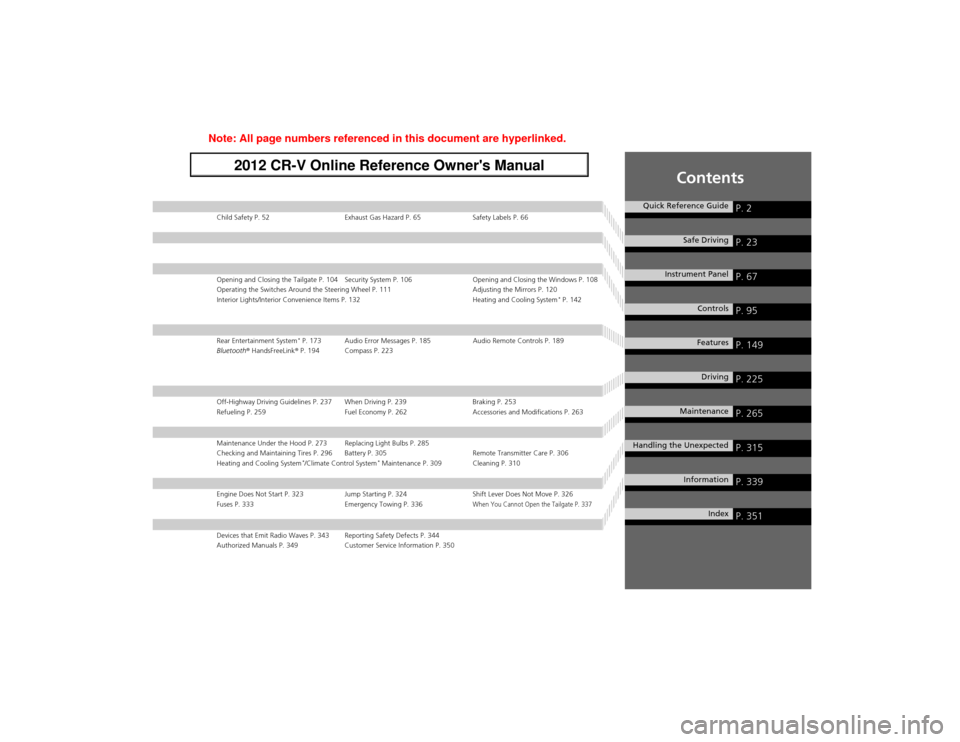
Contents
Child Safety P. 52 Exhaust Gas Hazard P. 65 Safety Labels P. 66
Opening and Closing the Tailgate P. 104 Security System P. 106 Opening and Closing the Windows P. 108
Operating the Switches Around the Steering Wheel P. 111 Adjusting the Mirrors P. 120
Interior Lights/Interior Convenience Items P. 132 Heating and Cooling System*
P. 142
Rear Entertainment System *
P. 173 Audio Error Messages P. 185 Audio Remote Controls P. 189
Bluetooth ® HandsFreeLink ® P. 194 Compass P. 223
Off-Highway Driving Guidelines P. 237 When Driving P. 239 Braking P. 253
Refueling P. 259 Fuel Economy P. 262 Accessories and Modifications P. 263
Maintenance Under the Hood P. 273 Replacing Light Bulbs P. 285
Checking and Maintaining Tires P. 296 Battery P. 305 Remote Transmitter Care P. 306
Heating and Cooling System *
/Climate Control System *
Maintenance P. 309 Cleaning P. 310
Engine Does Not Start P. 323 Jump Starting P. 324 Shift Lever Does Not Move P. 326
Fuses P. 333 Emergency Towing P. 336When You Cannot Open the Tailgate P. 337
Devices that Emit Radio Waves P. 343 Reporting Safety Defects P. 344
Authorized Manuals P. 349 Customer Service Information P. 350
Quick Reference GuideP. 2
Safe DrivingP. 23
Instrument PanelP. 67
ControlsP. 95
FeaturesP. 149
DrivingP. 225
MaintenanceP. 265
Handling the UnexpectedP. 315
InformationP. 339
IndexP. 351
Note: All page numbers referenced in this document are hyperlinked.
2012 CR-V Online Reference Owner's Manual
Page 9 of 361
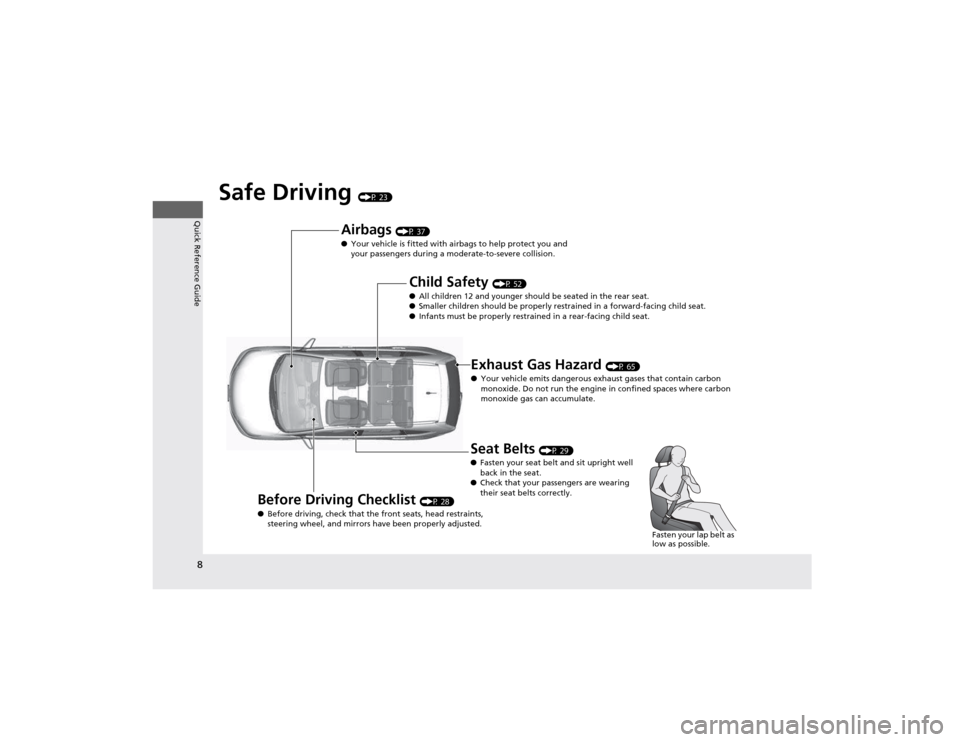
8
Quick Reference Guide
Safe Driving (P 23)
Airbags (P 37)
● Your vehicle is fitted with airbags to help protect you and
your passengers during a moderate-to-severe collision.
Child Safety (P 52)
● All children 12 and younger should be seated in the rear seat.
● Smaller children should be properly restrained in a forward-facing child seat.
● Infants must be properly restrained in a rear-facing child seat.
Exhaust Gas Hazard (P 65)
● Your vehicle emits dangerous exhaust gases that contain carbon
monoxide. Do not run the engine in confined spaces where carbon
monoxide gas can accumulate.
Before Driving Checklist (P 28)
● Before driving, check that the front seats, head restraints,
steering wheel, and mirrors have been properly adjusted. Seat Belts
(P 29)
● Fasten your seat belt and sit upright well
back in the seat.
● Check that your passengers are wearing
their seat belts correctly.
Fasten your lap belt as
low as possible.
Page 18 of 361
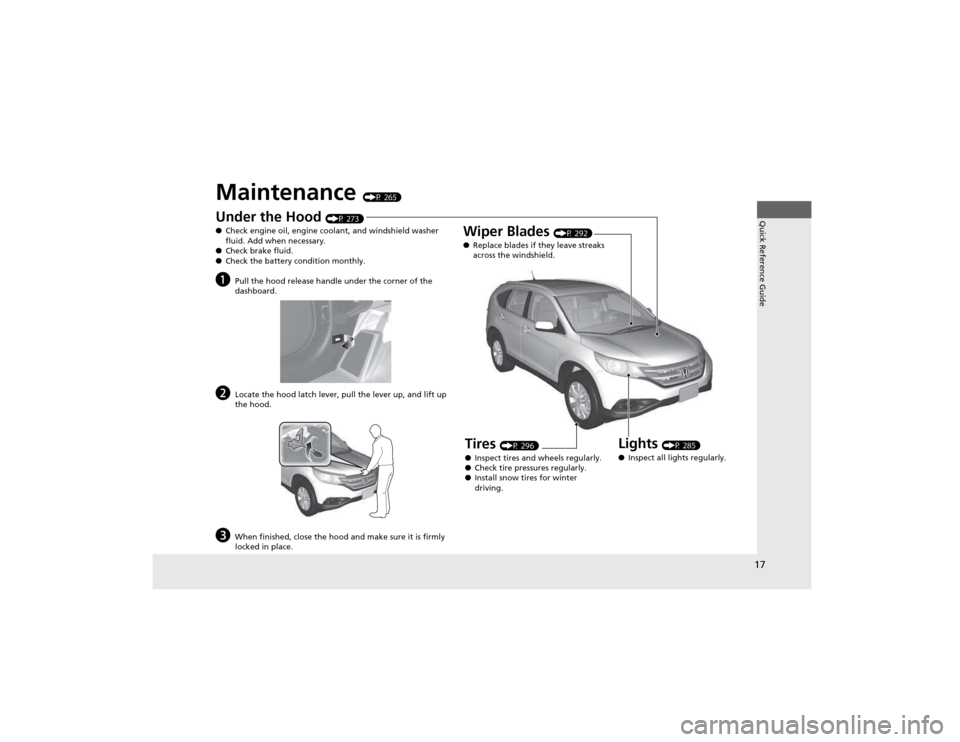
17
Quick Reference Guide
Maintenance (P 265)
Under the Hood (P 273)
● Check engine oil, engine coolant, and windshield washer
fluid. Add when necessary.
● Check brake fluid.
● Check the battery condition monthly.
a Pull the hood release handle under the corner of the
dashboard.
b Locate the hood latch lever, pull the lever up, and lift up
the hood.
c When finished, close the hood and make sure it is firmly
locked in place.
Lights (P 285)
● Inspect all lights regularly.
Wiper Blades
(P 292)
● Replace blades if they leave streaks
across the windshield.
Tires (P 296)
● Inspect tires and wheels regularly.
● Check tire pressures regularly.
● Install snow tires for winter
driving.
Page 19 of 361
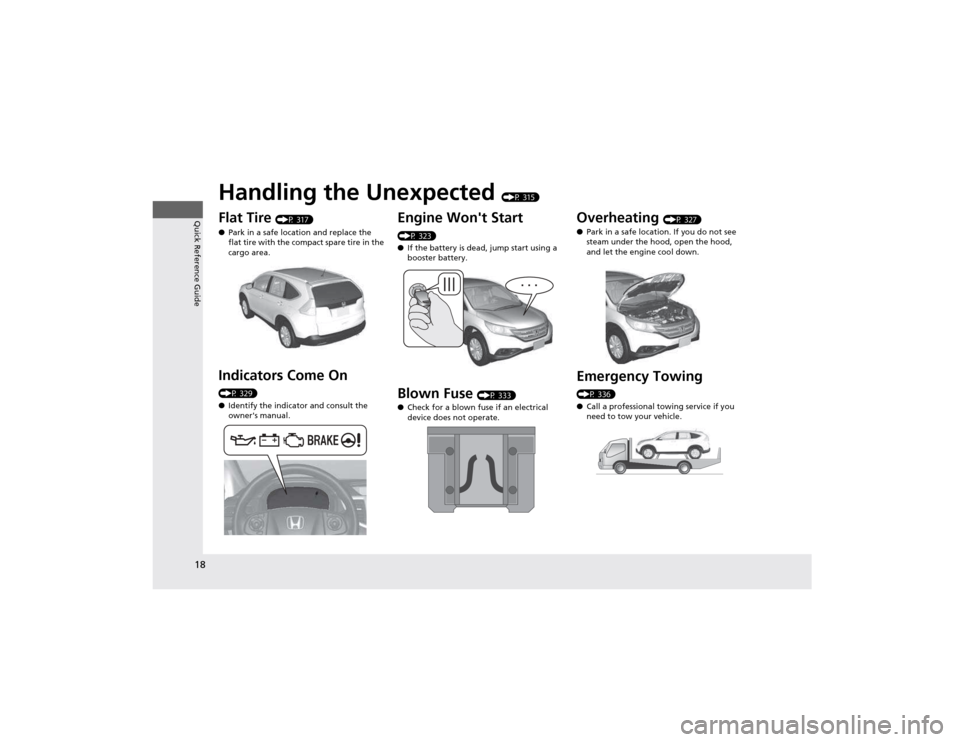
18
Quick Reference Guide
Handling the Unexpected (P 315)
Flat Tire (P 317)
● Park in a safe location and replace the
flat tire with the compact spare tire in the
cargo area.
Indicators Come On
(P 329) ● Identify the indicator and consult the
owner's manual.
Engine Won't Start
(P 323) ●If the battery is dead, jump start using a
booster battery.
Blown Fuse (P 333)
● Check for a blown fuse if an electrical
device does not operate.Overheating (P 327)
● Park in a safe location. If you do not see
steam under the hood, open the hood,
and let the engine cool down.
Emergency Towing
(P 336) ● Call a professional towing service if you
need to tow your vehicle.
Page 69 of 361
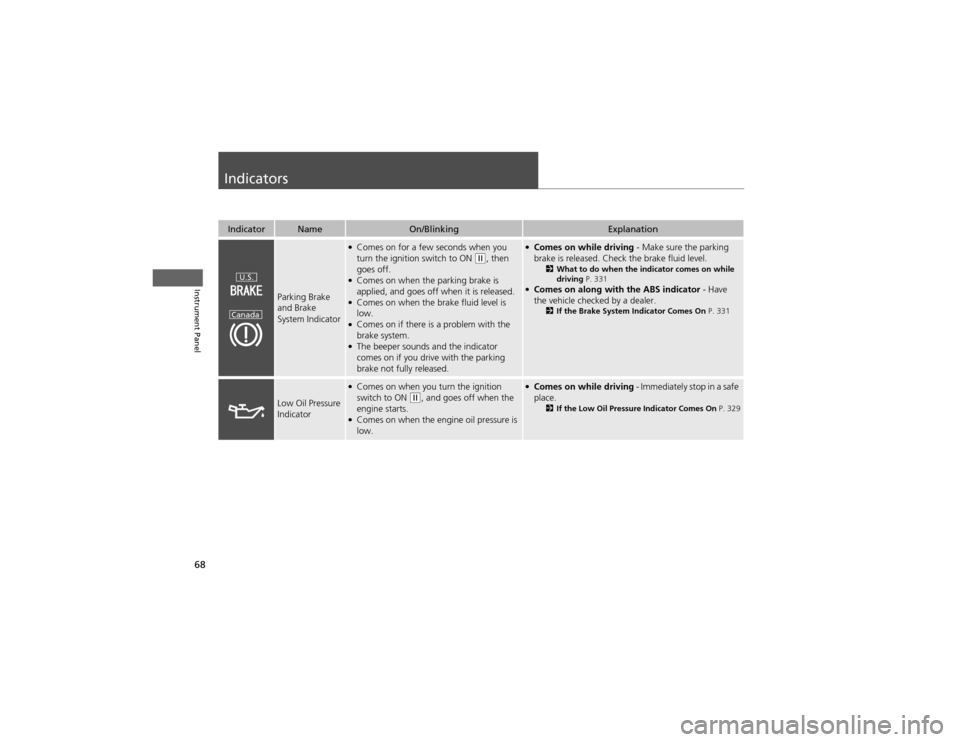
68
Instrument Panel
Indicators
IndicatorNameOn/BlinkingExplanation
Parking Brake and Brake
System Indicator
●Comes on for a few seconds when you
turn the ignition switch to ON
(w , then
goes off.
● Comes on when the parking brake is
applied, and goes off when it is released.
● Comes on when the brake fluid level is
low.
● Comes on if there is a problem with the
brake system.
● The beeper sounds and the indicator
comes on if you drive with the parking
brake not fully released.
● Comes on while driving - Make sure the parking
brake is released. Check the brake fluid level. 2What to do when the indicator comes on while
driving P. 331
● Comes on along with the ABS indicator - Have
the vehicle checked by a dealer. 2If the Brake System Indicator Comes On P. 331
Low Oil Pressure
Indicator
●
Comes on when you turn the ignition
switch to ON
(w , and goes off when the
engine starts.
● Comes on when the engine oil pressure is
low.
● Comes on while driving - Immediately stop in a safe
place. 2If the Low Oil Pressure Indicator Comes On P. 329
U.S.
Canada
Page 70 of 361
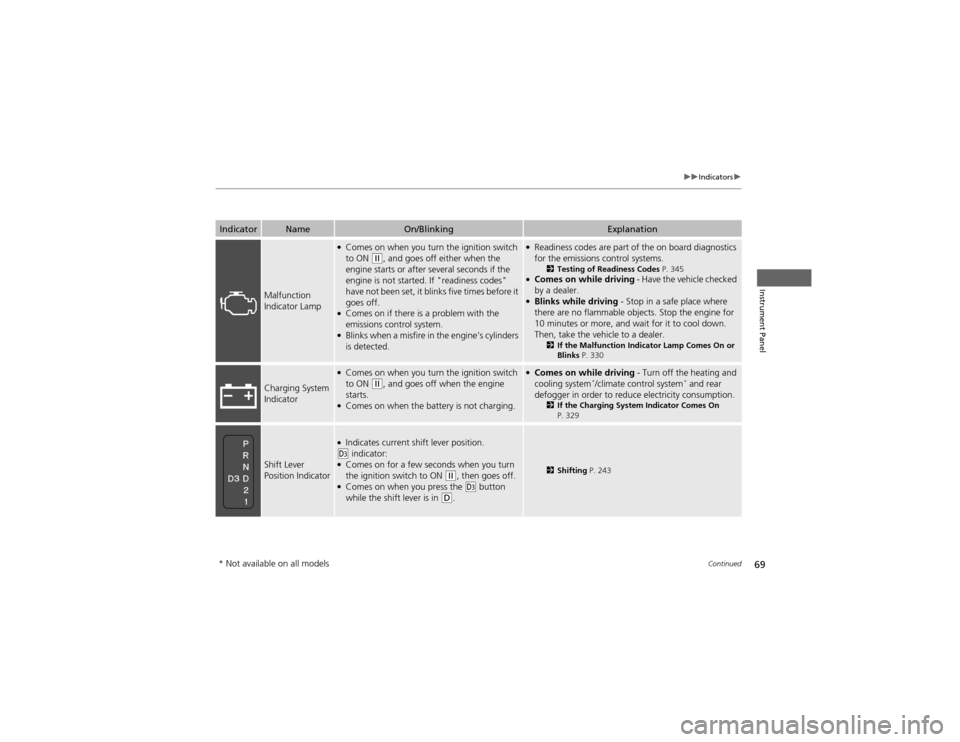
69
uuIndicatorsu
Continued
Instrument Panel
IndicatorNameOn/BlinkingExplanation
Malfunction
Indicator Lamp
●Comes on when you turn the ignition switch to ON
(w , and goes off either when the
engine starts or after several seconds if the
engine is not started. If "readiness codes"
have not been set, it blinks five times before it goes off.
● Comes on if there is a problem with the
emissions control system.
● Blinks when a misfire in the engine's cylinders
is detected.
● Readiness codes are part of the on board diagnostics
for the emissions control systems.
2Testing of Readiness Codes P. 345
● Comes on while driving - Have the vehicle checked
by a dealer.
● Blinks while driving - Stop in a safe place where
there are no flammable objects. Stop the engine for
10 minutes or more, and wait for it to cool down.
Then, take the vehicle to a dealer. 2If the Malfunction Indicator Lamp Comes On or
Blinks P. 330
Charging System
Indicator
●
Comes on when you turn the ignition switch to ON
(w , and goes off when the engine
starts.
● Comes on when the battery is not charging.
● Comes on while driving - Turn off the heating and
cooling system *
/climate control system *
and rear
defogger in order to reduce electricity consumption. 2If the Charging System Indicator Comes On
P. 329
Shift Lever
Position Indicator
● Indicates current shift lever position.
(d indicator:
● Comes on for a few seconds when you turn the ignition switch to ON
(w , then goes off.
● Comes on when you press the (d button
while the shift lever is in (D .
2 Shifting P. 243
* Not available on all models
Page 72 of 361
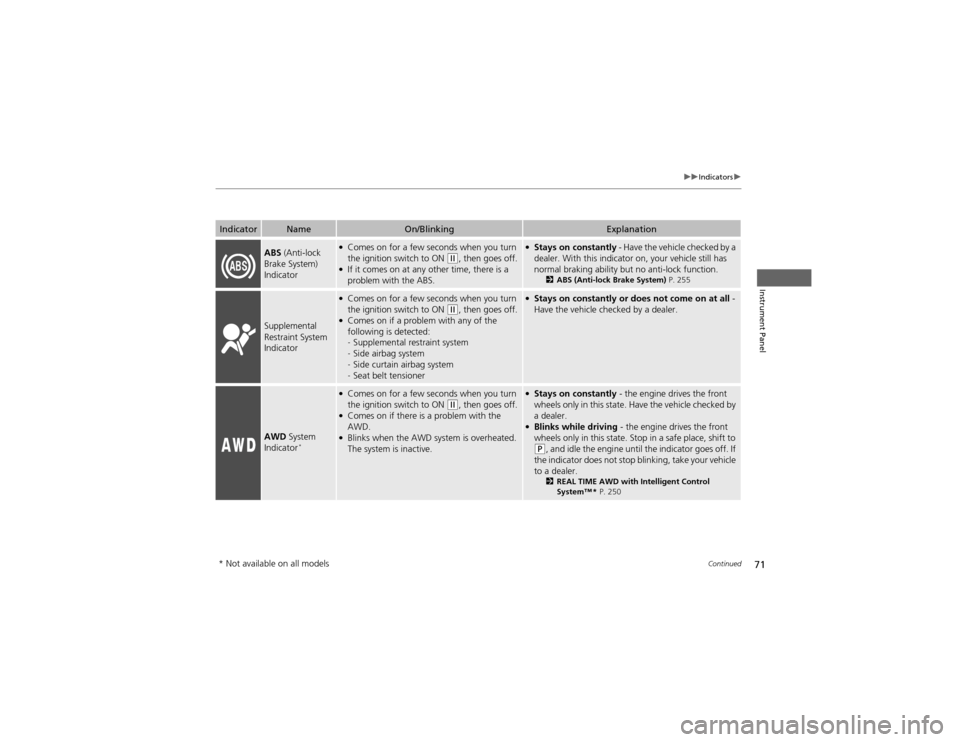
71
uuIndicatorsu
Continued
Instrument Panel
IndicatorNameOn/BlinkingExplanation
ABS (Anti-lock
Brake System)
Indicator● Comes on for a few seconds when you turn
the ignition switch to ON
(w , then goes off.
● If it comes on at any other time, there is a
problem with the ABS.
●Stays on constantly - Have the vehicle checked by a
dealer. With this indicator on, your vehicle still has
normal braking ability but no anti-lock function. 2ABS (Anti-lock Brake System) P. 255
Supplemental
Restraint System
Indicator
●
Comes on for a few seconds when you turn
the ignition switch to ON
(w , then goes off.
● Comes on if a problem with any of the
following is detected:-Supplemental restraint system
- Side airbag system
- Side curtain airbag system
- Seat belt tensioner
●
Stays on constantly or does not come on at all -
Have the vehicle checked by a dealer.
AWD System
Indicator *
●
Comes on for a few seconds when you turn
the ignition switch to ON
(w , then goes off.
● Comes on if there is a problem with the AWD.
● Blinks when the AWD system is overheated.
The system is inactive.
●Stays on constantly - the engine drives the front
wheels only in this state. Have the vehicle checked by
a dealer.
● Blinks while driving - the engine drives the front
wheels only in this state. Stop in a safe place, shift to
(P , and idle the engine until the indicator goes off. If
the indicator does not stop blinking, take your vehicle
to a dealer. 2REAL TIME AWD with Intelligent Control
System
Page 74 of 361
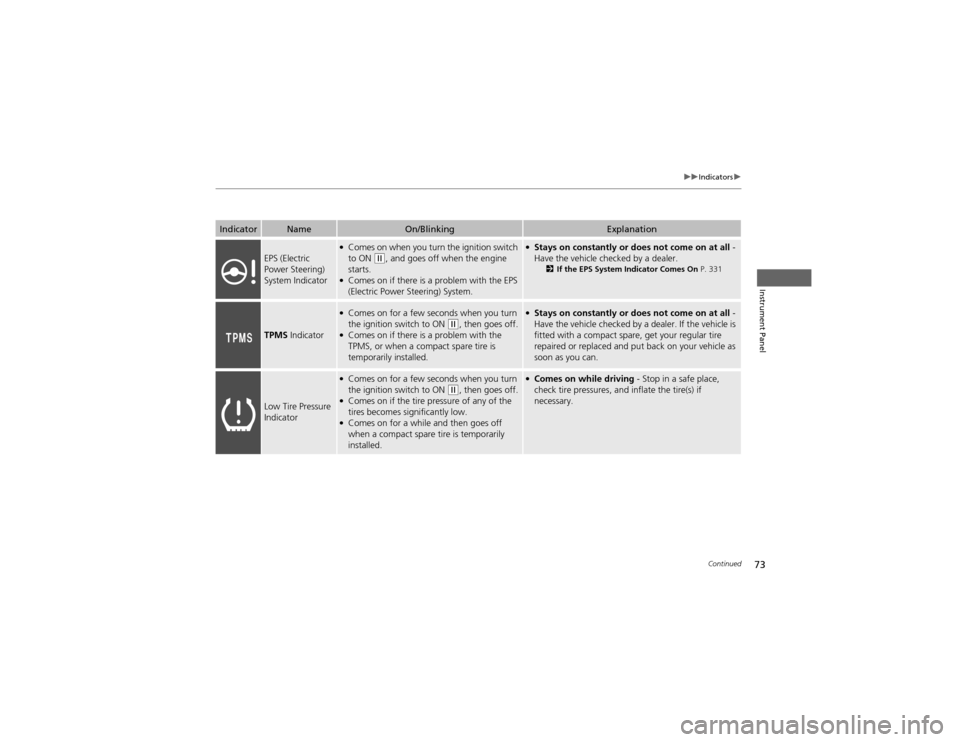
73
uuIndicatorsu
Continued
Instrument Panel
IndicatorNameOn/BlinkingExplanation
EPS (Electric
Power Steering)
System Indicator
●Comes on when you turn the ignition switch to ON
(w , and goes off when the engine
starts.
● Comes on if there is a problem with the EPS
(Electric Power Steering) System.
● Stays on constantly or does not come on at all -
Have the vehicle checked by a dealer. 2If the EPS System Indicator Comes On P. 331
TPMS Indicator
●
Comes on for a few seconds when you turn
the ignition switch to ON
(w , then goes off.
● Comes on if there is a problem with the
TPMS, or when a compact spare tire is
temporarily installed.
● Stays on constantly or does not come on at all -
Have the vehicle checked by a dealer. If the vehicle is
fitted with a compact spare, get your regular tire
repaired or replaced and put back on your vehicle as
soon as you can.
Low Tire Pressure
Indicator
● Comes on for a few seconds when you turn
the ignition switch to ON
(w , then goes off.
● Comes on if the tire pressure of any of the
tires becomes significantly low.
● Comes on for a while and then goes off
when a compact spare tire is temporarily
installed.
● Comes on while driving - Stop in a safe place,
check tire pressures, and inflate the tire(s) if
necessary.
Page 76 of 361
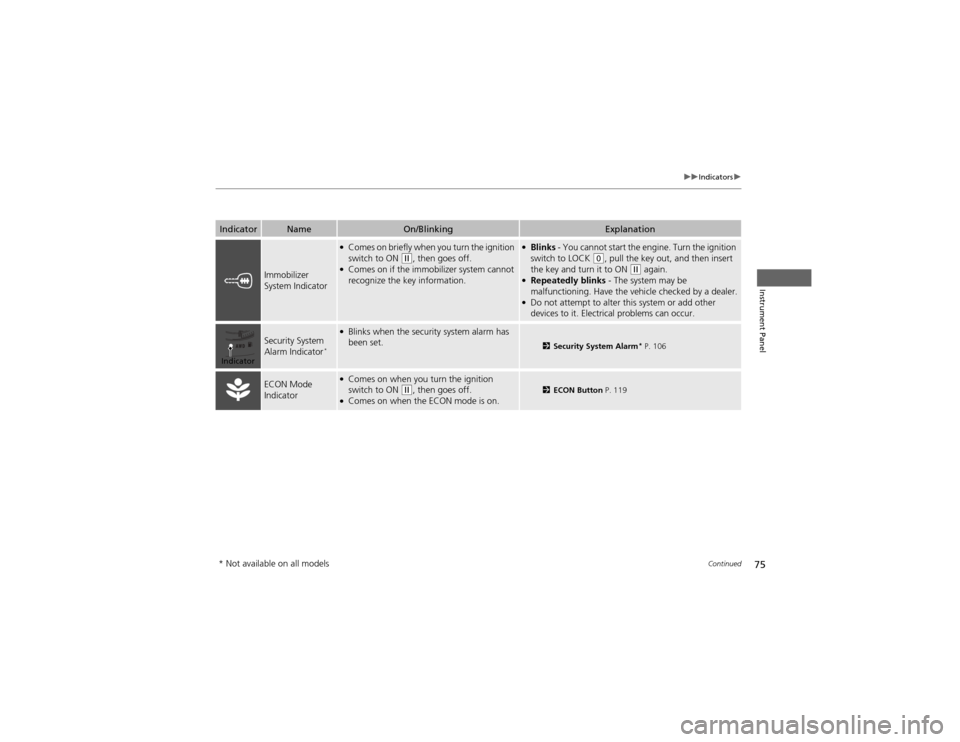
75
uuIndicatorsu
Continued
Instrument Panel
IndicatorNameOn/BlinkingExplanation
Immobilizer
System Indicator
●Comes on briefly when you turn the ignition
switch to ON
(w , then goes off.
● Comes on if the immobilizer system cannot
recognize the key information.
● Blinks - You cannot start the engine. Turn the ignition
switch to LOCK
(0 , pull the key out, and then insert
the key and turn it to ON (w again.
● Repeatedly blinks - The system may be
malfunctioning. Have the vehicle checked by a dealer.
● Do not attempt to alter this system or add other
devices to it. Electrical problems can occur.
Security System Alarm Indicator *●
Blinks when the security system alarm has
been set.
2 Security System Alarm *
P. 106
ECON Mode
Indicator● Comes on when you turn the ignition
switch to ON
(w , then goes off.
● Comes on when the ECON mode is on.2 ECON Button P. 119
Indicator
* Not available on all models
Page 227 of 361
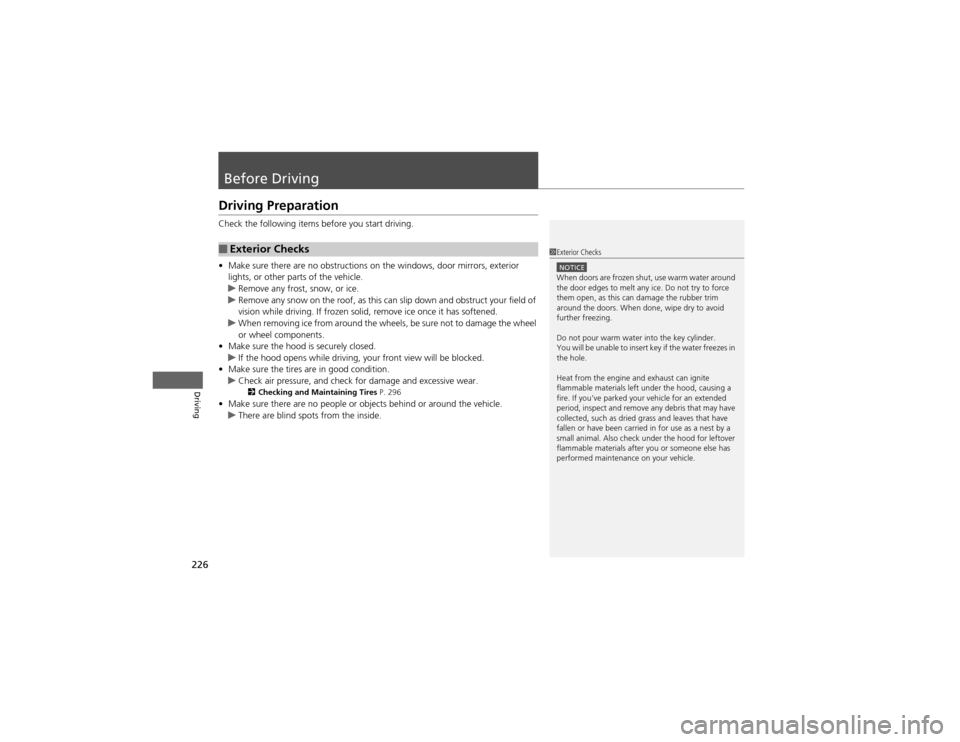
226
Driving
Before Driving
Driving Preparation
Check the following items before you start driving. •Make sure there are no obstructions on the windows, door mirrors, exterior
lights, or other parts of the vehicle.
uRemove any frost, snow, or ice.uRemove any snow on the roof, as this can slip down and obstruct your field of
vision while driving. If frozen solid, remove ice once it has softened.
uWhen removing ice from around the wheels, be sure not to damage the wheel
or wheel components.
• Make sure the hood is securely closed.
uIf the hood opens while driving, your front view will be blocked.
• Make sure the tires are in good condition.
uCheck air pressure, and check for damage and excessive wear.
2 Checking and Maintaining Tires P. 296
• Make sure there are no people or objects behind or around the vehicle.
uThere are blind spots from the inside.
■Exterior Checks1Exterior Checks
NOTICEWhen doors are frozen shut, use warm water around
the door edges to melt any ice. Do not try to force
them open, as this can damage the rubber trim
around the doors. When done, wipe dry to avoid further freezing.
Do not pour warm water into the key cylinder.
You will be unable to insert key if the water freezes in
the hole.
Heat from the engine and exhaust can ignite
flammable materials left under the hood, causing a
fire. If you've parked your vehicle for an extended
period, inspect and remove any debris that may have
collected, such as dried grass and leaves that have
fallen or have been carried in for use as a nest by a
small animal. Also check under the hood for leftover
flammable materials after you or someone else has
performed maintenance on your vehicle.